Kelvin probe force microscope
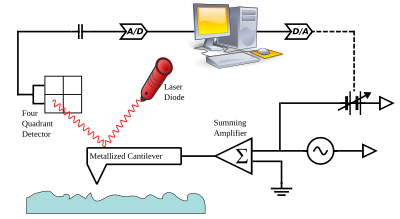
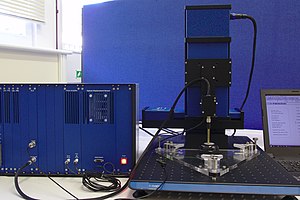
Kelvin probe force microscopy (KPFM), also known as surface potential microscopy, is a noncontact variant of atomic force microscopy (AFM).[1][2][3] By raster scanning in the x,y plane the work function of the sample can be locally mapped for correlation with sample features. When there is little or no magnification, this approach can be described as using a scanning Kelvin probe (SKP). These techniques are predominantly used to measure corrosion and coatings.
With KPFM, the work function of surfaces can be observed at atomic or molecular scales. The work function relates to many surface phenomena, including catalytic activity, reconstruction of surfaces, doping and band-bending of semiconductors, charge trapping in dielectrics and corrosion. The map of the work function produced by KPFM gives information about the composition and electronic state of the local structures on the surface of a solid.
History
[edit]The SKP technique is based on parallel plate capacitor experiments performed by Lord Kelvin in 1898.[4] In the 1930s William Zisman built upon Lord Kelvin's experiments to develop a technique to measure contact potential differences of dissimilar metals.[5]
Working principle
[edit]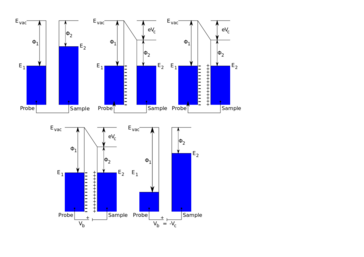
In SKP the probe and sample are held parallel to each other and electrically connected to form a parallel plate capacitor. The probe is selected to be of a different material to the sample, therefore each component initially has a distinct Fermi level. When electrical connection is made between the probe and the sample electron flow can occur between the probe and the sample in the direction of the higher to the lower Fermi level. This electron flow causes the equilibration of the probe and sample Fermi levels. Furthermore, a surface charge develops on the probe and the sample, with a related potential difference known as the contact potential (Vc). In SKP the probe is vibrated along a perpendicular to the plane of the sample.[6] This vibration causes a change in probe to sample distance, which in turn results in the flow of current, taking the form of an ac sine wave. The resulting ac sine wave is demodulated to a dc signal through the use of a lock-in amplifier.[7] Typically the user must select the correct reference phase value used by the lock-in amplifier. Once the dc potential has been determined, an external potential, known as the backing potential (Vb) can be applied to null the charge between the probe and the sample. When the charge is nullified, the Fermi level of the sample returns to its original position. This means that Vb is equal to -Vc, which is the work function difference between the SKP probe and the sample measured.[8]
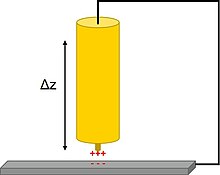
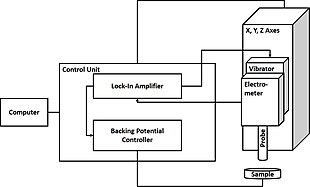
The cantilever in the AFM is a reference electrode that forms a capacitor with the surface, over which it is scanned laterally at a constant separation. The cantilever is not piezoelectrically driven at its mechanical resonance frequency ω0 as in normal AFM although an alternating current (AC) voltage is applied at this frequency.
When there is a direct-current (DC) potential difference between the tip and the surface, the AC+DC voltage offset will cause the cantilever to vibrate. The origin of the force can be understood by considering that the energy of the capacitor formed by the cantilever and the surface is
plus terms at DC. Only the cross-term proportional to the VDC·VAC product is at the resonance frequency ω0. The resulting vibration of the cantilever is detected using usual scanned-probe microscopy methods (typically involving a diode laser and a four-quadrant detector). A null circuit is used to drive the DC potential of the tip to a value which minimizes the vibration. A map of this nulling DC potential versus the lateral position coordinate therefore produces an image of the work function of the surface.
A related technique, electrostatic force microscopy (EFM), directly measures the force produced on a charged tip by the electric field emanating from the surface. EFM operates much like magnetic force microscopy in that the frequency shift or amplitude change of the cantilever oscillation is used to detect the electric field. However, EFM is much more sensitive to topographic artifacts than KPFM. Both EFM and KPFM require the use of conductive cantilevers, typically metal-coated silicon or silicon nitride. Another AFM-based technique for the imaging of electrostatic surface potentials, scanning quantum dot microscopy,[9] quantifies surface potentials based on their ability to gate a tip-attached quantum dot.
Factors affecting SKP measurements
[edit]The quality of an SKP measurement is affected by a number of factors. This includes the diameter of the SKP probe, the probe to sample distance, and the material of the SKP probe. The probe diameter is important in the SKP measurement because it affects the overall resolution of the measurement, with smaller probes leading to improved resolution.[10][11] On the other hand, reducing the size of the probe causes an increase in fringing effects which reduces the sensitivity of the measurement by increasing the measurement of stray capacitances.[10] The material used in the construction of the SKP probe is important to the quality of the SKP measurement.[12] This occurs for a number of reasons. Different materials have different work function values which will affect the contact potential measured. Different materials have different sensitivity to humidity changes. The material can also affect the resulting lateral resolution of the SKP measurement. In commercial probes tungsten is used,[13] though probes of platinum,[14] copper,[15] gold,[16] and NiCr has been used.[17] The probe to sample distance affects the final SKP measurement, with smaller probe to sample distances improving the lateral resolution [11] and the signal-to-noise ratio of the measurement.[18] Furthermore, reducing the SKP probe to sample distance increases the intensity of the measurement, where the intensity of the measurement is proportional to 1/d2, where d is the probe to sample distance.[19] The effects of changing probe to sample distance on the measurement can be counteracted by using SKP in constant distance mode.
Work function
[edit]The Kelvin probe force microscope or Kelvin force microscope (KFM) is based on an AFM set-up and the determination of the work function is based on the measurement of the electrostatic forces between the small AFM tip and the sample. The conducting tip and the sample are characterized by (in general) different work functions, which represent the difference between the Fermi level and the vacuum level for each material. If both elements were brought in contact, a net electric current would flow between them until the Fermi levels were aligned. The difference between the work functions is called the contact potential difference and is denoted generally with VCPD. An electrostatic force exists between tip and sample, because of the electric field between them. For the measurement a voltage is applied between tip and sample, consisting of a DC-bias VDC and an AC-voltage VAC sin(ωt) of frequency ω.
Tuning the AC-frequency to the resonant frequency of the AFM cantilever results in an improved sensitivity. The electrostatic force in a capacitor may be found by differentiating the energy function with respect to the separation of the elements and can be written as
where C is the capacitance, z is the separation, and V is the voltage, each between tip and surface. Substituting the previous formula for voltage (V) shows that the electrostatic force can be split up into three contributions, as the total electrostatic force F acting on the tip then has spectral components at the frequencies ω and 2ω.
The DC component, FDC, contributes to the topographical signal, the term Fω at the characteristic frequency ω is used to measure the contact potential and the contribution F2ω can be used for capacitance microscopy.
Contact potential measurements
[edit]For contact potential measurements a lock-in amplifier is used to detect the cantilever oscillation at ω. During the scan VDC will be adjusted so that the electrostatic forces between the tip and the sample become zero and thus the response at the frequency ω becomes zero. Since the electrostatic force at ω depends on VDC − VCPD, the value of VDC that minimizes the ω-term corresponds to the contact potential. Absolute values of the sample work function can be obtained if the tip is first calibrated against a reference sample of known work function.[20] Apart from this, one can use the normal topographic scan methods at the resonance frequency ω independently of the above. Thus, in one scan, the topography and the contact potential of the sample are determined simultaneously. This can be done in (at least) two different ways: 1) The topography is captured in AC mode which means that the cantilever is driven by a piezo at its resonant frequency. Simultaneously the AC voltage for the KPFM measurement is applied at a frequency slightly lower than the resonant frequency of the cantilever. In this measurement mode the topography and the contact potential difference are captured at the same time and this mode is often called single-pass. 2) One line of the topography is captured either in contact or AC mode and is stored internally. Then, this line is scanned again, while the cantilever remains on a defined distance to the sample without a mechanically driven oscillation but the AC voltage of the KPFM measurement is applied and the contact potential is captured as explained above. It is important to note that the cantilever tip must not be too close to the sample in order to allow good oscillation with applied AC voltage. Therefore, KPFM can be performed simultaneously during AC topography measurements but not during contact topography measurements.
Applications
[edit]The Volta potential measured by SKP is directly proportional to the corrosion potential of a material,[21] as such SKP has found widespread use in the study of the fields of corrosion and coatings. In the field of coatings for example, a scratched region of a self-healing shape memory polymer coating containing a heat generating agent on aluminium alloys was measured by SKP.[22] Initially after the scratch was made the Volta potential was noticeably higher and wider over the scratch than over the rest of the sample, implying this region is more likely to corrode. The Volta potential decreased over subsequent measurements, and eventually the peak over the scratch completely disappeared implying the coating has healed. Because SKP can be used to investigate coatings in a non-destructive way it has also been used to determine coating failure. In a study of polyurethane coatings, it was seen that the work function increases with increasing exposure to high temperature and humidity.[23] This increase in work function is related to decomposition of the coating likely from hydrolysis of bonds within the coating.
Using SKP the corrosion of industrially important alloys has been measured.[citation needed] In particular with SKP it is possible to investigate the effects of environmental stimulus on corrosion. For example, the microbially induced corrosion of stainless steel and titanium has been examined.[24] SKP is useful to study this sort of corrosion because it usually occurs locally, therefore global techniques are poorly suited. Surface potential changes related to increased localized corrosion were shown by SKP measurements. Furthermore, it was possible to compare the resulting corrosion from different microbial species. In another example SKP was used to investigate biomedical alloy materials, which can be corroded within the human body. In studies on Ti-15Mo under inflammatory conditions,[25] SKP measurements showed a lower corrosion resistance at the bottom of a corrosion pit than at the oxide protected surface of the alloy. SKP has also been used to investigate the effects of atmospheric corrosion, for example to investigate copper alloys in marine environment.[26] In this study Kelvin potentials became more positive, indicating a more positive corrosion potential, with increased exposure time, due to an increase in thickness of corrosion products. As a final example SKP was used to investigate stainless steel under simulated conditions of gas pipeline.[27] These measurements showed an increase in difference in corrosion potential of cathodic and anodic regions with increased corrosion time, indicating a higher likelihood of corrosion. Furthermore, these SKP measurements provided information about local corrosion, not possible with other techniques.
SKP has been used to investigate the surface potential of materials used in solar cells, with the advantage that it is a non-contact, and therefore a non-destructive technique.[28] It can be used to determine the electron affinity of different materials in turn allowing the energy level overlap of conduction bands of differing materials to be determined. The energy level overlap of these bands is related to the surface photovoltage response of a system.[29]
As a non-contact, non-destructive technique SKP has been used to investigate latent fingerprints on materials of interest for forensic studies.[30] When fingerprints are left on a metallic surface they leave behind salts which can cause the localized corrosion of the material of interest. This leads to a change in Volta potential of the sample, which is detectable by SKP. SKP is particularly useful for these analyses because it can detect this change in Volta potential even after heating, or coating by, for example, oils.
SKP has been used to analyze the corrosion mechanisms of schreibersite-containing meteorites.[31][32] The aim of these studies has been to investigate the role in such meteorites in releasing species utilized in prebiotic chemistry.
In the field of biology SKP has been used to investigate the electric fields associated with wounding,[33] and acupuncture points.[34]
In the field of electronics, KPFM is used to investigate the charge trapping in High-k gate oxides/interfaces of electronic devices.[35][36][37]
See also
[edit]References
[edit]- ^ M. Nonnenmacher; M. P. O'Boyle; H. K. Wickramasinghe (1991). "Kelvin probe force microscopy" (PDF). Appl. Phys. Lett. 58 (25): 2921. Bibcode:1991ApPhL..58.2921N. doi:10.1063/1.105227. Archived from the original (free-download pdf) on 2009-09-20.
- ^ Fujihira, Masamichi (1999). "Kelvin Probe Force Microscopy of Molecular Surfaces". Annual Review of Materials Science. 29 (1): 353–380. Bibcode:1999AnRMS..29..353F. doi:10.1146/annurev.matsci.29.1.353. ISSN 0084-6600.
- ^ Melitz, Wilhelm; Shen, Jian; Kummel, Andrew C.; Lee, Sangyeob (2011). "Kelvin probe force microscopy and its application". Surface Science Reports. 66 (1): 1–27. Bibcode:2011SurSR..66....1M. doi:10.1016/j.surfrep.2010.10.001. ISSN 0167-5729.
- ^ Kelvin, Lord (1898). "V. Contact electricity of metals". The London, Edinburgh, and Dublin Philosophical Magazine and Journal of Science. 46 (278): 82–120. doi:10.1080/14786449808621172. ISSN 1941-5982.
- ^ Zisman, W. A. (1932). "A New Method of Measuring Contact Potential Differences in Metals". Review of Scientific Instruments. 3 (7): 367–370. Bibcode:1932RScI....3..367Z. doi:10.1063/1.1748947. ISSN 0034-6748.
- ^ Rohwerder, Michael; Turcu, Florin (2007). "High-resolution Kelvin probe microscopy in corrosion science: Scanning Kelvin probe force microscopy (SKPFM) versus classical scanning Kelvin probe (SKP)". Electrochimica Acta. 53 (2): 290–299. doi:10.1016/j.electacta.2007.03.016.
- ^ Cheran, Larisa-Emilia; Johnstone, Sherri; Sadeghi, Saman; Thompson, Michael (2007-01-19). "Work-function measurement by high-resolution scanning Kelvin nanoprobe". Measurement Science and Technology. 18 (3): 567–578. Bibcode:2007MeScT..18..567C. doi:10.1088/0957-0233/18/3/005. ISSN 0957-0233. S2CID 123457387.
- ^ Surplice, N A; D'Arcy, R J (1970). "A critique of the Kelvin method of measuring work functions". Journal of Physics E: Scientific Instruments. 3 (7): 477–482. doi:10.1088/0022-3735/3/7/201. ISSN 0022-3735.
- ^ Wagner, Christian; Green, Matthew F. B.; Leinen, Philipp; Deilmann, Thorsten; Krüger, Peter; Rohlfing, Michael; Temirov, Ruslan; Tautz, F. Stefan (2015-07-06). "Scanning Quantum Dot Microscopy". Physical Review Letters. 115 (2): 026101. arXiv:1503.07738. Bibcode:2015PhRvL.115b6101W. doi:10.1103/PhysRevLett.115.026101. ISSN 0031-9007. PMID 26207484. S2CID 1720328.
- ^ a b Wicinski, Mariusz; Burgstaller, Wolfgang; Hassel, Achim Walter (2016). "Lateral resolution in scanning Kelvin probe microscopy". Corrosion Science. 104: 1–8. doi:10.1016/j.corsci.2015.09.008.
- ^ a b McMurray, H. N.; Williams, G. (2002). "Probe diameter and probe–specimen distance dependence in the lateral resolution of a scanning Kelvin probe". Journal of Applied Physics. 91 (3): 1673–1679. Bibcode:2002JAP....91.1673M. doi:10.1063/1.1430546. ISSN 0021-8979.
- ^ Huber, Silvia; Wicinski, Mariusz; Hassel, Achim Walter (2018). "Suitability of Various Materials for Probes in Scanning Kelvin Probe Measurements". Physica Status Solidi A. 215 (15): 1700952. Bibcode:2018PSSAR.21500952H. doi:10.1002/pssa.201700952.
- ^ "High Resolution Scanning Kelvin Probe". Bio-Logic Science Instruments. Retrieved 2019-05-17.
- ^ Hansen, Douglas C.; Hansen, Karolyn M.; Ferrell, Thomas L.; Thundat, Thomas (2003). "Discerning Biomolecular Interactions Using Kelvin Probe Technology". Langmuir. 19 (18): 7514–7520. doi:10.1021/la034333w. ISSN 0743-7463.
- ^ Dirscherl, Konrad; Baikie, Iain; Forsyth, Gregor; Heide, Arvid van der (2003). "Utilisation of a micro-tip scanning Kelvin probe for non-invasive surface potential mapping of mc-Si solar cells". Solar Energy Materials and Solar Cells. 79 (4): 485–494. doi:10.1016/S0927-0248(03)00064-3.
- ^ Stratmann, M. (1987). "The investigation of the corrosion properties of metals, covered with adsorbed electrolyte layers—A new experimental technique". Corrosion Science. 27 (8): 869–872. doi:10.1016/0010-938X(87)90043-6.
- ^ Nazarov, A. P.; Thierry, D. (2001). "Study of the Carbon Steel/Alkyd Coating Interface with a Scanning Vibrating Capacitor Technique". Protection of Metals. 37 (2): 108–119. doi:10.1023/a:1010361702449. ISSN 0033-1732. S2CID 92117439.
- ^ "Height tracking with the SKP370 or SKP470 module" (PDF). Bio-Logic Science Instruments. Retrieved 2019-05-17.
- ^ Wapner, K.; Schoenberger, B.; Stratmann, M.; Grundmeier, G. (2005). "Height-Regulating Scanning Kelvin Probe for Simultaneous Measurement of Surface Topology and Electrode Potentials at Buried Polymer/Metal Interfaces". Journal of the Electrochemical Society. 152 (3): E114. Bibcode:2005JElS..152E.114W. doi:10.1149/1.1856914.
- ^ Fernández Garrillo, P. A.; Grévin, B.; Chevalier, N.; Borowik, Ł. (2018). "Calibrated work function mapping by Kelvin probe force microscopy" (PDF). Review of Scientific Instruments. 89 (4): 043702. Bibcode:2018RScI...89d3702F. doi:10.1063/1.5007619. PMID 29716375.
- ^ "SKP imaging example of a corroded Zn-plated Fe sample" (PDF). Bio-Logic Science Instruments. Retrieved 2019-05-17.
- ^ Fan, Weijie; Zhang, Yong; Li, Weihua; Wang, Wei; Zhao, Xiaodong; Song, Liying (2019). "Multi-level self-healing ability of shape memory polyurethane coating with microcapsules by induction heating". Chemical Engineering Journal. 368: 1033–1044. doi:10.1016/j.cej.2019.03.027. S2CID 104432686.
- ^ Borth, David J.; Iezzi, Erick B.; Dudis, Douglas S.; Hansen, Douglas C. (2019). "Nondestructive Evaluation of Urethane-Ester Coating Systems Using the Scanning Kelvin Probe Technique". Corrosion. 75 (5): 457–464. doi:10.5006/3020. ISSN 0010-9312. S2CID 105314795.
- ^ Zhang, Dawei; Zhou, Feichi; Xiao, Kui; Cui, Tianyu; Qian, Hongchong; Li, Xiaogang (2015). "Microbially Influenced Corrosion of 304 Stainless Steel and Titanium by P. variotii and A. niger in Humid Atmosphere". Journal of Materials Engineering and Performance. 24 (7): 2688–2698. Bibcode:2015JMEP...24.2688Z. doi:10.1007/s11665-015-1558-2. ISSN 1059-9495. S2CID 137116966.
- ^ Szklarska, M.; Dercz, G.; Kubisztal, J.; Balin, K.; Łosiewicz, B. (2016). "Semi-Conducting Properties of Titanium Dioxide Layer on Surface of Ti-15Mo Implant Alloy in Biological Milieu". Acta Physica Polonica A. 130 (4): 1085–1087. Bibcode:2016AcPPA.130.1085S. doi:10.12693/APhysPolA.130.1085. ISSN 0587-4246.
- ^ Kong, Decheng; Dong, Chaofang; Ni, Xiaoqing; Man, Cheng; Xiao, Kui; Li, Xiaogang (2018). "Insight into the mechanism of alloying elements (Sn, Be) effect on copper corrosion during long-term degradation in harsh marine environment". Applied Surface Science. 455: 543–553. Bibcode:2018ApSS..455..543K. doi:10.1016/j.apsusc.2018.06.029. S2CID 102769318.
- ^ Jin, Z.H.; Ge, H.H.; Lin, W.W.; Zong, Y.W.; Liu, S.J.; Shi, J.M. (2014). "Corrosion behaviour of 316L stainless steel and anti-corrosion materials in a high acidified chloride solution". Applied Surface Science. 322: 47–56. Bibcode:2014ApSS..322...47J. doi:10.1016/j.apsusc.2014.09.205.
- ^ Dirscherl, Konrad; Baikie, Iain; Forsyth, Gregor; Heide, Arvid van der (2003). "Utilisation of a micro-tip scanning Kelvin probe for non-invasive surface potential mapping of mc-Si solar cells". Solar Energy Materials and Solar Cells. 79 (4): 485–494. doi:10.1016/s0927-0248(03)00064-3. ISSN 0927-0248.
- ^ Liu, Xiangyang; Zheng, Haiwu; Zhang, Jiwei; Xiao, Yin; Wang, Zhiyong (2013). "Photoelectric properties and charge dynamics for a set of solid state solar cells with Cu4Bi4S9 as the absorber layer". Journal of Materials Chemistry A. 1 (36): 10703. doi:10.1039/c3ta11830d. ISSN 2050-7488.
- ^ Williams, Geraint; McMurray, H. N. (2008). "Human Fingerprint - Metal Interactions Studied Using a Scanning Kelvin Probe". ECS Transactions. 11 (22). Washington, DC: ECS: 81–89. Bibcode:2008ECSTr..11v..81W. doi:10.1149/1.2925265. S2CID 98393112.
- ^ Bryant, David E.; Greenfield, David; Walshaw, Richard D.; Evans, Suzanne M.; Nimmo, Alexander E.; Smith, Caroline L.; Wang, Liming; Pasek, Matthew A.; Kee, Terence P. (2009). "Electrochemical studies of iron meteorites: phosphorus redox chemistry on the early Earth". International Journal of Astrobiology. 8 (1): 27–36. Bibcode:2009IJAsB...8...27B. doi:10.1017/S1473550408004345. ISSN 1473-5504. S2CID 97821022.
- ^ Bryant, David E.; Greenfield, David; Walshaw, Richard D.; Johnson, Benjamin R.G.; Herschy, Barry; Smith, Caroline; Pasek, Matthew A.; Telford, Richard; Scowen, Ian (2013). "Hydrothermal modification of the Sikhote-Alin iron meteorite under low pH geothermal environments. A plausibly prebiotic route to activated phosphorus on the early Earth". Geochimica et Cosmochimica Acta. 109: 90–112. Bibcode:2013GeCoA.109...90B. doi:10.1016/j.gca.2012.12.043.
- ^ Nuccitelli, Richard; Nuccitelli, Pamela; Ramlatchan, Samdeo; Sanger, Richard; Smith, Peter J.S. (2008). "Imaging the electric field associated with mouse and human skin wounds". Wound Repair and Regeneration. 16 (3): 432–441. doi:10.1111/j.1524-475X.2008.00389.x. ISSN 1067-1927. PMC 3086402. PMID 18471262.
- ^ Gow, Brian J.; Cheng, Justine L.; Baikie, Iain D.; Martinsen, Ørjan G.; Zhao, Min; Smith, Stephanie; Ahn, Andrew C. (2012). "Electrical Potential of Acupuncture Points: Use of a Noncontact Scanning Kelvin Probe". Evidence-Based Complementary and Alternative Medicine. 2012: 632838. doi:10.1155/2012/632838. ISSN 1741-427X. PMC 3541002. PMID 23320033.
- ^ Tzeng, S.-D.; Gwo, S. (2006-07-15). "Charge trapping properties at silicon nitride/silicon oxide interface studied by variable-temperature electrostatic force microscopy". Journal of Applied Physics. 100 (2): 023711–023711–9. Bibcode:2006JAP...100b3711T. doi:10.1063/1.2218025. ISSN 0021-8979.
- ^ Khosla, Robin; Kumar, Pawan; Sharma, Satinder K. (December 2015). "Charge Trapping and Decay Mechanism in Post Deposition Annealed Er2O3 MOS Capacitors by Nanoscopic and Macroscopic Characterization". IEEE Transactions on Device and Materials Reliability. 15 (4): 610–616. doi:10.1109/TDMR.2015.2498310. ISSN 1530-4388. S2CID 33548746.
- ^ Khosla, Robin; Rolseth, Erlend Granbo; Kumar, Pawan; Vadakupudhupalayam, Senthil Srinivasan; Sharma, Satinder K.; Schulze, Jorg (March 2017). "Charge Trapping Analysis of Metal/Al 2 O 3 /SiO 2 /Si, Gate Stack for Emerging Embedded Memories". IEEE Transactions on Device and Materials Reliability. 17 (1): 80–89. doi:10.1109/TDMR.2017.2659760. ISSN 1530-4388. S2CID 24247825.
External links
[edit]- Masaki Takihara (9 December 2008). "Kelvin probe force microscopy". Takahashi Lab., Institute of Industrial Science, University of Tokyo. Archived from the original on 29 October 2012. Retrieved 29 February 2012. – Full description of the principles with good illustrations to aid comprehension
- Transport measurements by Scanning Probe Microscopy
- Introduction to Kelvin Probe Force Microscopy (KPFM)
- Dynamic Kelvin Probe Force Microscopy
- Kelvin Probe Force Microscopy of Lateral Devices
- Kelvin Probe Force Microscopy in Liquids
- Current-voltage Measurements in Scanning Probe Microscopy
- Dynamic IV measurements in SPM

![{\displaystyle E={\frac {1}{2}}C[V_{DC}+V_{AC}\sin(\omega _{0}t)]^{2}={\frac {1}{2}}C[2V_{DC}V_{AC}\sin(\omega _{0}t)-{\frac {1}{2}}V_{AC}^{2}\cos(2\omega _{0}t)]}](https://wikimedia.riteme.site/api/rest_v1/media/math/render/svg/76406b6101633873a2d25b45bd1f08ff43d7c571)



![{\displaystyle F_{DC}={\frac {dC}{dz}}\left[{\frac {1}{2}}(V_{DC}-V_{CPD})^{2}+{\frac {1}{4}}V_{AC}^{2}\right]}](https://wikimedia.riteme.site/api/rest_v1/media/math/render/svg/86b07fe8708356480525c3eeff00a115029218c6)
![{\displaystyle F_{\omega }={\frac {dC}{dz}}[V_{DC}-V_{CPD}]V_{AC}\sin(\omega t)}](https://wikimedia.riteme.site/api/rest_v1/media/math/render/svg/1826a211f72a4518e388609ea082454aba51239f)

